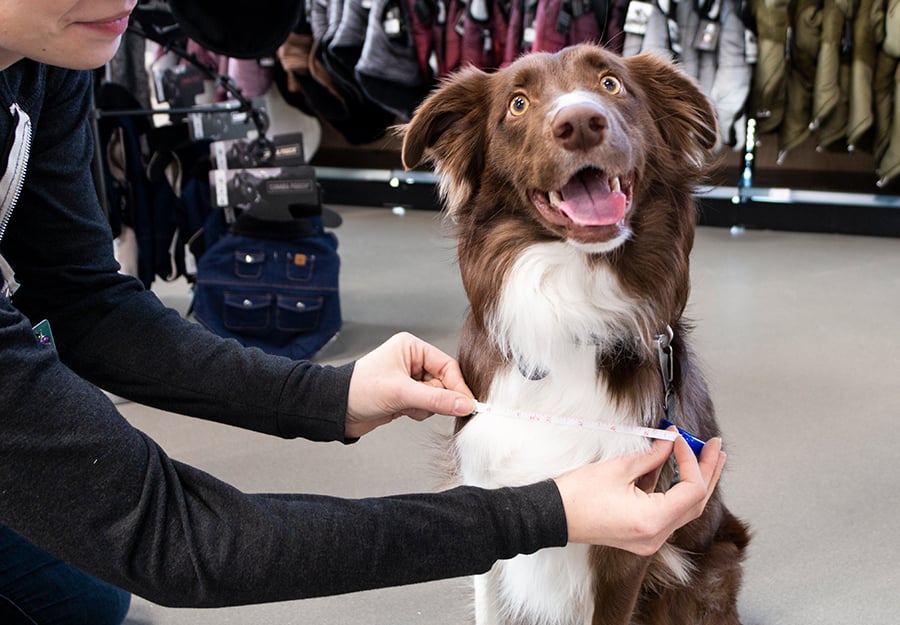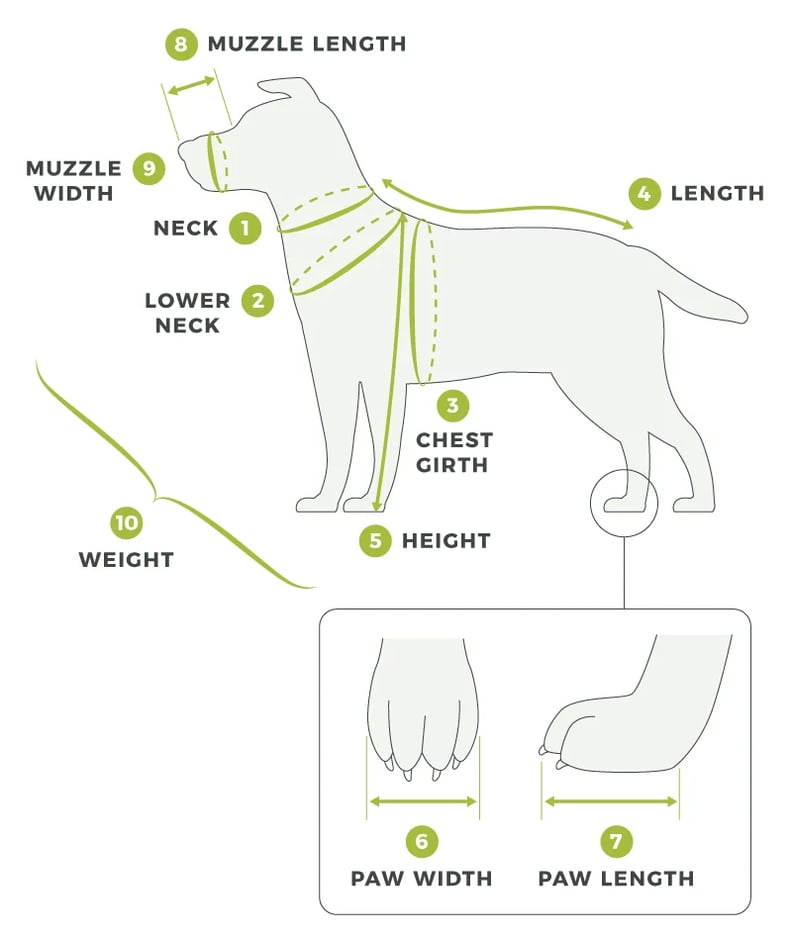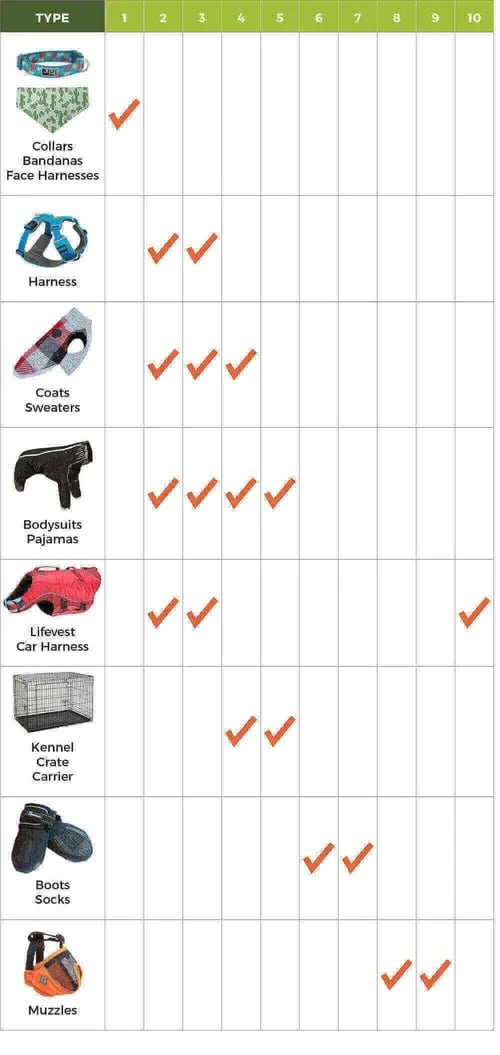
So your dog needs a coat, but how do you know what size will fit? Learn how to measure a dog so that you can choose the doggy apparel that will be comfortable and safe no matter the season.
You brought home a new sweater for your dog, only to find that it doesn't fit. You looked at the tag, and it said 40-60 lbs. Your dog is right in that sweet spot, so why doesn't it fit?
Before you head back to the pet store, check out our tips on how to measure your dog for clothes, a dog collar, and other gear.
Whether you own French Bulldogs or Great Danes, we will provide tips on how to get the right fit every time.
It's frustrating to waste time and money only to discover that the sizing guidelines that you were given weren't totally accurate.
If you arm yourself with a simple tape measure, you can measure your dog's neck and chest girth to ensure the perfect fit.
Many dog clothing brands provide a vague range of measurements, and one of the most notoriously unhelpful ways that dog apparel brands size their garments is by providing a weight.
Sizing your dog's clothes can be a struggle. You'll need an accurate measurement of your dog before making a purchase. Use the tape measure to measure your dog.
Every type and brand of clothing will fit differently, and the wrong fit defeats the purpose.
In short, you want to begin at the base of the neck, using a tape measure to get chest girth, neck girth, the size of its shoulder blades, and more--especially if you are measuring your dog for harnesses.
Typically, a dog's height doesn't matter when fitting clothing.
One Size Does Not Fit All
When choosing any of your dog's outdoor gear, you need to consider the style and whether it will work for your dog's shape, which means you'll need to take your dog's measurements.
I recommend keeping a file of your dog's measurements that you can update yearly.
You'll need a soft measuring tape measure. This will give you the most accurate values. You can use a string and tape measure in a pinch to determine the best size for clothing and collars.
Always calculate when your dog is standing. Record the following measurements of the dog's body to choose the right size of apparel:
-
- Dog's height when standing straight
- Dog's shoe size
- Dog's withers
- Pet's neck circumference
- Shoulders (at the highest point) to measure your dog's height when standing
- Back length
- Chest girth

How to Measure Your Dog?
Measuring your dog isn't overly complicated, but a few best practices will make the process easier and less stressful for you and your dog.
Finding the perfect fit is vital to keeping them comfortable and safe. Refer to the size charts for each article of clothing to determine the correct size:

5 Tips for Measuring Your Dog
- Choose a calm, quiet environment.
- Your dog must be standing when you measure dog height. If your dog is sitting or lying down, your measurements will not be accurate.
- If you are in Canada, or if the product is made outside of North America, the measurements they give you might be in centimetres instead of inches.
- If your dog is fidgety or won't stand still for you, try using an incentive like food to keep him still. Giving him a chew like a bully stick can be helpful, but may encourage him to lay down to chew it. Instead, smear some dog-safe peanut butter on a dinner plate or a Kong toy and have someone hold the dog treat near your dog's face.
- Measure twice. Always, always measure twice. Mistakes happen, and it'll save you the time and hassle of making multiple trips to the pet store because the measurements were slightly off.
Even if your dog is fully grown, their weight and shape can fluctuate - always re-measure your dog once or twice a year to ensure that any new dog apparel you buy is comfortable and safe.
Sizing Dog Coats & Sweaters
Whether you are dressing your dog for cold weather, trying to keep them dry in the rain, or just looking to show off your dog's trendy fashion, getting the right measurements can help you find the best style and fit for your dog.
-
- Use the Two Finger Rule. When taking measurements, you should be able to fit two fingers between your dog's body and the measuring tape.
- Measuring girth means measuring the widest part of the chest circumference. Don't measure right behind the armpits unless that is the widest part of your dog's rib cage.
- Start length measurements where your dog's collar would sit, and go just to the base of the tail. You may find that some clothing will be the right fit for their girth but not length.
- If your dog is slimmer in the hips than the chest, look for one with leg straps to prevent the coat from flipping up at the back.
- Check their underbelly when trying on dog clothes. If the coat covers too far down their belly, you may need a smaller size for small dogs.
Tips for Sizing Dog Coats & Sweaters
Whether you are dressing your dog for cold weather, trying to keep them dry in the rain, or just looking to show off your dog's trendy fashion, getting the right measurements can help you find the best style and fit for your dog.
-
- Use the Two Finger Rule. When taking measurements, you should be able to fit two fingers between your dog's body and the measuring tape.
- Measuring girth means measuring the widest part of the chest circumference. Don't measure right behind the armpits unless that is the widest part of your dog's rib cage.
- Start length measurements where your dog's collar would sit, and go just to the base of the tail. You may find that some clothing will be the right fit for their girth but not length.
- If your dog is slimmer in the hips than the chest, then look for a that has leg straps to prevent the coat from flipping up at the back.
- Check their underbelly when trying on dog clothes. If the coat covers too far down their belly, you may need a smaller size for small dogs.
Fitting Dog Boots & Socks
Dog boots are one of the most challenging types of apparel to size.
There are many different styles of boots, and not all will work for every pair of front legs.
-
- Not every paw will be the same size. Front and back paws often differ, sometimes enough to require different boot sizes. Make sure you measure all of their paws.
- When trying boots on your dog, try all four and allow them to walk around indoors. This will let you know how snug the boots are and if they will stay in a comfortable position. Poorly sized boots will fall off.
- Dogs with wide paws, even smaller breeds, may need larger boots. This may mean that the boots are looser above the paw.
- Pick boot styles that suit the shape of their paws.
- Some boots will have a hard, flat sole that can help to keep their paws stable when they walk.
- Choose softer, more flexible materials that allow the boot to bend with the shape of their paw.
Bonus Sizing Tips
You've measured your dog and seen your options, but there are still a few small things to consider before you run the checkout.
-
- When possible, it's best to bring your dog to try the item in-store. If that is not possible, or if you are shopping online, make sure you can return or exchange the item before you spend your hard-earned money on it.
- Not every sizing chart will be 100% accurate, so despite your best efforts, you could still end up with an ill-fitting item. Keep the packaging and receipt, and always inquire about the return policy.
- If your dog is an “in-betweener”, meaning he falls between two sizes of an item, always go for the larger size or pick a different style.
- Don't fret about the weight guidelines for the product. Two dogs that both weigh 50 lbs may need to wear different sizes to accommodate their body types.
- Always consider your dog's mobility. Harnesses and apparel that cover the dog's shoulder blades could limit movement.
- When sizing a kennel, crate, or carrier, always consider your dog's comfort. Your dog should be able to stand, turn around, and lie down comfortably.
- Muzzles should be secure but never tight. They need to be able to open their mouth to pant, and should not interfere with their vision or movement.
Frequently Asked Questions About Measuring Your Dog
How do I measure my dog for a harness?
To measure for a harness, use a flexible measuring tape to determine the circumference of your dog's chest right behind the front legs and around the shoulder blades. Ensure the tape is snug but not tight when measuring the circumference.
What measurements are needed for a dog collar?
For a collar, measure your dog's neck circumference, where the collar will sit comfortably. Leave enough room so two fingers can slip snugly between the collar and your dog's neck.
How should I measure for a dog coat or sweater?
To measure for a coat or sweater, start from the base of your dog's neck to the base of their tail. Also, measure the circumference of the widest part of your dog's chest.
What's the process for measuring paw size for dog boots?
To measure paw size for dog boots, press your dog's paw onto a piece of paper to mimic the weight-bearing shape. Measure the width and length of this imprint to ensure you pick the proper dog bootie or shoe size for your pup.
How do I measure for doggie boots with adjustable straps?
Measure the circumference of your dog's paw at the widest point. Then, measure the length from the tip of the longest toenail to the back of the paw pad.
What's the best way to measure a dog's for various clothing?
To measure your dog's girth, wrap the measuring tape around the widest part of your dog's chest, just behind their front legs. Check out our measurement chart for more tips for measuring your dog for dog clothes.
.png?width=200&height=66&name=logo%20(1).png)


.jpg)
